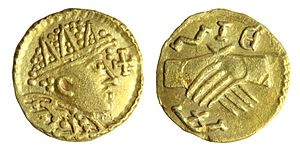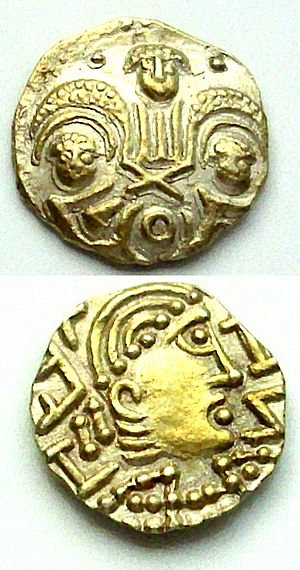Thrymsa facts for kids
The thrymsa (pronounced THRIM-sa) was a special gold coin made in Anglo-Saxon England way back in the 600s. These coins were first copied from older Roman coins and coins from the Merovingian kingdom in France, which had a lot of gold in them.
But over time, between the 630s and 650s, the amount of gold in new thrymsas kept getting less and less. After about 655, some new thrymsas had less than 35% gold! By around 675, people stopped making thrymsas completely. A new silver coin called the sceat took its place.
The Thrymsa's Journey: A Look at Its History
The very first thrymsas were made in England starting in the 630s. These early coins came from places like Canterbury, London, and maybe even Winchester. Some historians think these coins were made because trade became much busier after Æthelberht of Kent, a king, married Bertha of Kent, who was a princess from the powerful Frankish kingdom.
At first, thrymsas had a good amount of gold, usually between 40% and 70%. But as time went on, the gold was slowly replaced with other metals. This process is called debasement. After about 655, the coins had less than 35% gold. By around 675, gold coins were no longer made in England. Instead, people started using silver coins called sceats.
Later on, in Anglo-Saxon writings, the word "thrymsa" was used to mean a value equal to four silver pennies. We know about thrymsas today because they have been found in special collections of old coins called "hoards." A famous one is the Crondall Hoard.
Interestingly, a very old ship burial site called Sutton Hoo, from the early 600s, had 37 French gold coins (Merovingian tremisses) but no English thrymsas. However, the Crondall Hoard, which is from a bit later (after 630), contained 101 gold coins. Out of these, 69 were Anglo-Saxon thrymsas, and 24 were from the Frankish kingdom.
What Did Thrymsas Look Like?
Early thrymsas were made to look like the French tremisses or even older Roman coins. They were quite small, weighing about 1 to 3 grams, which is like a few paper clips. They were also small in size, usually about 13 millimeters across, which is roughly the size of a modern button.
Later thrymsas had many different pictures and symbols on them. Some showed faces or busts of people. Others had crosses, objects that looked like lyres (a type of harp), or symbols from Roman armies. Many thrymsas also had words written on them. Sometimes these words were in Latin script (like the letters we use today), and sometimes they were in Anglo-Saxon runes, which was an older alphabet.
See also
Gallery
Comparison of continental and English coins:
-
Tremissis of a Frankish king Dagobert I (c. 603–639 AD)
-
Gold Thrymsa c. 620–645 AD from the Crondall hoard in Hampshire
-
Thrymsa found in Suffolk, c. 500–675






